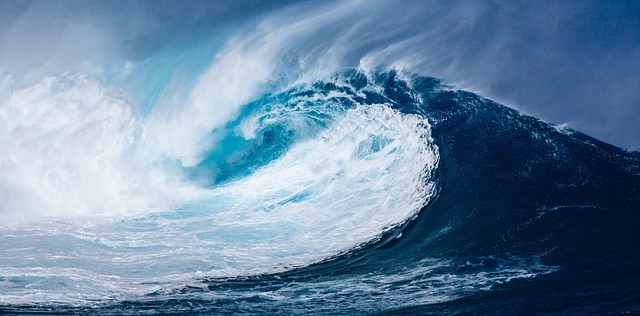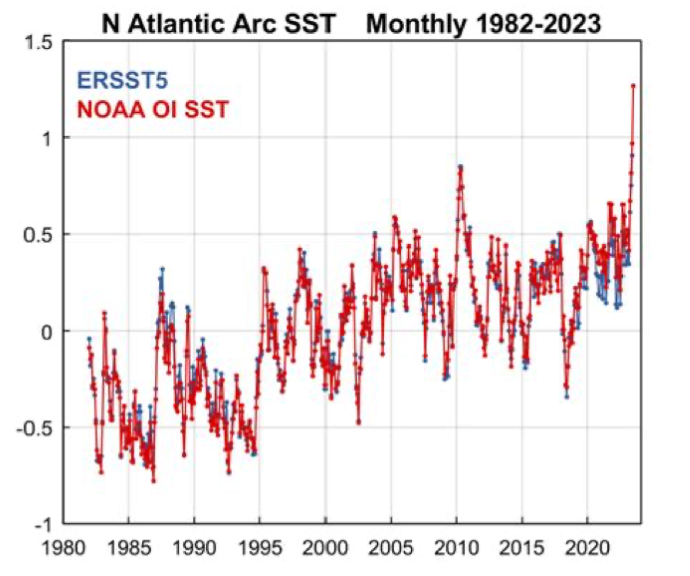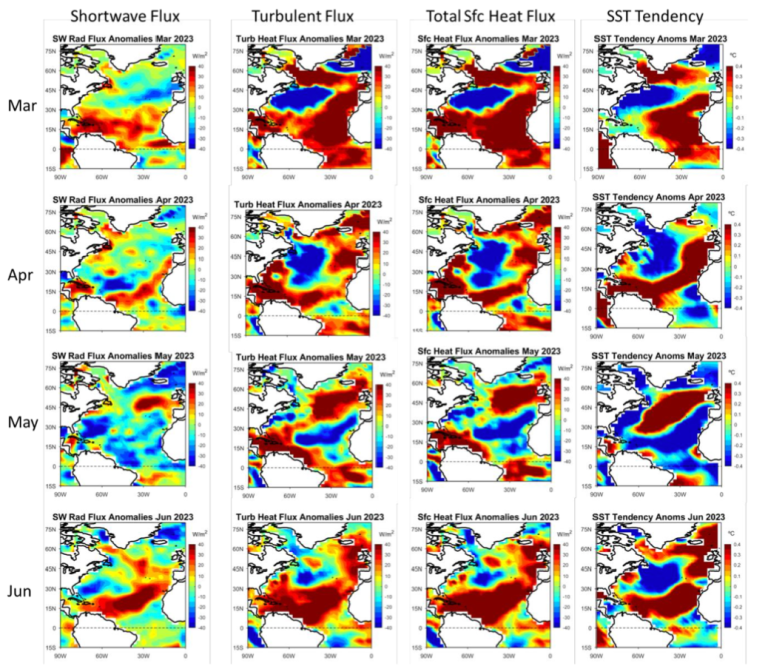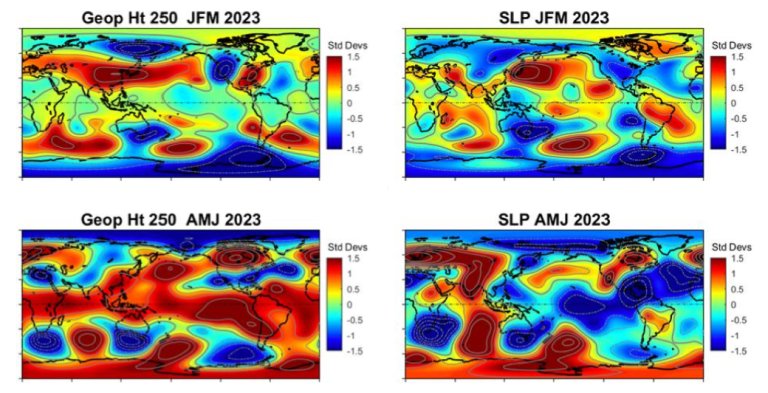by Jim Johnstone and Judith Curry reposted from Climate Etc.

With the Atlantic hurricane season underway, we are closely monitoring the exceptionally warm SSTs in the Atlantic. This post describes what has been happening and why.
Atlantic SSTs
Sea surface temperatures (SSTs) over much of the North Atlantic are exceptionally high in late June 2023, due largely to a period of rapid warming that began around March-April.

Figure 1. SST anomalies on June 27, 2023 (top) and daily time series for regions marked above.
Daily SST time series in Fig. 1 show the recent SST evolution in several regions, marked in the map above, including the eastern Pacific Niño3 region, the North Atlantic Arc, the Caribbean Sea and the tropical North Atlantic Main Development Region (MDR). North Atlantic SST indices show evidence of irregular warming since March-April and peak warmth in early June. Warm conditions in the eastern equatorial Pacific reflect current El Niño conditions, which have intensified steadily since the beginning of 2023.
Local SST anomalies ≥1°C (1995-2019 baseline) are present throughout a basin-scale ‘Arc’ pattern that represents the leading natural structure of coherent SST variability on a wide range of time scales (Fig 1). The exceptional magnitude of recent North Atlantic warming can be seen in monthly Arc-averaged SST anomalies back to 1980, illustrated in Figure 2. Following a period of relatively little variability since 2020, Arc SST elevated steeply over the past several months, reaching a historic maximum in June.

Figure 2. Monthly Arc-averaged SST anomalies from 1980 to June 2023.
Atmospheric circulation patterns
June atmospheric conditions over the North Atlantic are also highly unusual, as indicated by a North Atlantic Oscillation (NAO) index anomaly nearly 3 standard deviations below the monthly average. The NAO is defined by the subtropical – subpolar difference in atmospheric sea-level pressure (SLP) anomalies, and approximately reflects the intensity of the low-level atmospheric circulation over the North Atlantic basin. Extreme low NAO values in June are consistent with a very weak subtropical high (Bermuda High) and relatively stagnant surface winds, involving weakness of the midlatitude westerly flow and the tropical-subtropical easterly trade winds.
The climatological June SLP and surface wind patterns are shown in the left panel of Fig. 3. Conditions in June 2023, in the center panel, show a remarkably weak subtropical high and an absence of westerly surface winds in the midlatitudes. June 2023 SLP and wind anomalies, shown in the right panel, consist of unusually low pressure and cyclonic circulation over much of the basin, which reflects weakness of the mean anticyclonic flow pattern.

Figure 3. June patterns of atmospheric SLP and surface winds. Left: June averages (1995-2022). Center: Conditions in June 2023. Right: June 2023 anomalies (observations minus climatology). The + and – markers in the left panel show the centers of action of the North Atlantic Oscillation, calculated as the subtropical (+) minus subpolar (-) SLP anomaly difference.
An extreme negative NAO index in June was preceded by moderately negative anomalies in both March and April (Table 1), which led to repeated monthly warming of the North Atlantic Arc and extreme cumulative effects by late June. The Arc warming observed from February to June (+0.85°C) exceeds the total net Atlantic warming of the past century.

Table 1. Monthly anomalies of the NAO index, Arc SST tendency (dSST) and SST. March, April and June (red) were months of negative NAO anomalies (low subtropical SLP and weak surface winds) and Arc warming.
Figure 4 illustrates the magnitude of the June NAO anomaly in context of the historical record since 1980. The very low June 2023 NAO value is not unprecedented in the monthly climatological values; however, it is extremely low relative the previous June values and spring (Mar-Jun) values.

Figure 4. North Atlantic Oscillation (NAO) index, defined by the normalized subtropical (Azores) minus subpolar (Iceland) SLP anomaly difference. Top: Monthly anomalies (all months), with March-June 2023 values highlighted in red. Middle: June values. Bottom: March-June averages.
Coupled anomalies and changes
Atmospheric anomalies associated with the NAO are primary drivers of Arc SST perturbations over short (monthly to seasonal) time periods. Figure 5 illustrates monthly anomalies of net shortwave (solar) surface heat flux, turbulent (latent/evaporative plus sensible) heat flux, total heat flux, and SST tendencies. Negative NAO anomalies correspond to negative subtropical SLP anomalies and weak trade winds to the south, including the MDR. Weak trades warm the underlying sea surface primarily by hindering evaporative cooling, but affect tropical SSTs through several complementary mechanisms, simultaneously favoring warming through reductions in stratocumulus cloudiness, Saharan dust advection, upper-ocean mixing and coastal upwelling off NW Africa. Overall, the turbulent flux associated with weak winds has dominated over the shortwave flux in warming the Atlantic.

Figure 5. Monthly downward surface heat flux anomalies and SST tendencies from March through June 2023. Arc warming in March, April and June can be primarily explained by weak surface winds (due to – NAO anomalies) and low rates of evaporative cooling (positive turbulent heat flux).
The recurrence and growth of extreme NAO- conditions and Arc warmth in recent months is likely due in part to positive SST-atmosphere feedbacks. NAO / Arc patterns in the atmosphere / upper ocean are closely related to those of the Atlantic Meridional Mode (AMM), wherein warm SSTs and weak trade winds can be sustained or amplified through mutual reinforcement.
Another contributor to the remarkable spring changes in the North Atlantic may be the broader tropical warming involving the transition to El Niño conditions. Surface warming in the tropics typically leads to quasi-uniform elevation of tropospheric temperatures and geopotential heights throughout the tropical belt from ~20°N to 20°S. Spring increases in 250 hPa geopotential heights (Z250) over the tropics were accompanied by declines immediately poleward over the subtropical NE Pacific and North Atlantic, while SLP anomalies dropped steeply in a coherent tropical zone from the central Pacific to the eastern Atlantic.

Figure 6. Anomalies of 250 hPa geopotential heights (Z250) and SLP during JFM and AMJ 2023. Increases in tropical Z250, declines in subtropical Z250 and declines in tropical SLP occurred simultaneously over the E Pacific and N Atlantic in early 2023.
African dust, pollution, wild fire smoke and Hunga-Tonga
As shown in Figure 5, the extremely warm Atlantic SSTs this season is partly due to anomalous radiative warming of the surface. The twitterati have blamed many factors: CO2 emissions, lower amount of sulfate particles from clearer shipping fuels, Hunga-Tonga eruption, and low levels of African dust. And now the Canadian wildfires are a factor. These are all relatively minor factors compared to the dominant impact of variations in cloudiness.
Atmospheric particulates have been reduced globally from cleaner fuels for shipping that were mandated in 2020, which produce fewer sulfate particles. Sulfate particles have a cooling effect by reflecting solar radiation. Cleaner air means less solar radiation is reflected, which contributes to surface warming. Indirect effects include darkening of subtropical clouds, through cloud microphysical effects, which reduces the reflectivity of these clouds. The ocean warming effect of this would be largest in the Northern Hemisphere, and subtropical clouds are most susceptible to this kind of modification. In the image below you can see the ship tracks from the brighter clouds, that are more reflective of solar radiation (these ship tracks have now been substantially reduced) [link]
Particulates from wildfire smoke has a similar effect on reducing the solar warming at the surface. My contacts in New York estimated that solar power production was cut in half during the period when a thick layer of smoke from the Canadian wildfires. For smoke trajectories into the North Atlantic, there will be variable surface cooling, depending on the smoke trajectory and optical depth
African dust storms have the same effect in terms of reflecting solar radiation and thus cooling the surface. Dust storms have been anomalously weak so far (from Michael Lowry):

But the bottom line is that a major Saharan dust outbreak doesn’t have a big impact on sea surface temperatures: “Saharan dust outbreaks can decrease the surface shortwave radiation up to 190 W/m2, and an analysis of the corresponding SSTskin changes using a thermal skin model suggests dust-induced cooling effects as large as −0.24 K during daytime and a warming effect of up of 0.06 K during daytime and nighttime respectively.” [link]
Another radiative effect is from the Hunga-Tonga eruption in 2022. Normally volcanoes spew sulfate particles in the stratosphere, which reflects sunlight and so has a cooling effect on the surface. However the Hunga-Tonga eruption was associated with little sulfur dioxide (which converts into sulfate particles, with an estimated cooling impact of 0.004oC in 2022. The main climatic impact of Hunga-Tonga eruption is the large amount of water vapor that was ejected into the stratosphere from the Hunga-Tonga volcanic eruption, which is estimated to have increased stratospheric water content by 10-15% with a 0.034 oC global warming over the next 5 years. [link]
Here’s a screen shot from Zoom Earth on 6/24, showing smoke from the Canadian wildfires and African dust. The whiteness of the smoke in the satellite image, relative to the Saharan Dust, indicates the large optical depth of the smoke (which is proportional to the surface cooling effect).

Summary
The extreme North Atlantic conditions that developed in recent months are likely due to a combination of dynamical factors, including stochastic weather anomalies, regional positive feedbacks and global-scale changes. The high rate of recent Arc warming is particularly noticeable due to the extreme SST anomalies it produced; however comparable warming over periods of ~4 to 6 months occurred previously in late winter to spring seasons of 1983, 1987, 1989 and 2010 (Figure 2), which preceded a wide range of late summer hurricane anomalies.
The dominant cause of the warm SSTs is dynamical (atmospheric circulations) that modify surface wind speeds (evaporation; apparently the largest factor) and clouds (solar radiation). Minor non-cloud radiative impacts: Hunga-Tonga is a global effect, sulfate ship tracks is local ocean effect primarily in northern hemisphere, wildfire impact on oceans is relatively rare and event driven, and African dust is a regular summer feature that is characterized by discrete events. Cloud variability in most locations will dominate over aerosol forcing in terms of impacts on sea surface temperatures. Some minor Atlantic Ocean cooling can be expected with Canadian smoke and Saharan dust.
